
In our increasingly digital world, the ancient practice of mindfulness in nature offers a profound pathway back to our roots. When we step into natural settings with present-moment awareness, we open ourselves to a deeper relationship with the Earth that nourishes both our spirit and the environment around us. This conscious communion with nature isn’t just spiritually fulfilling—it’s scientifically proven to reduce stress, enhance focus, and foster a sense of belonging in the greater web of life. Join us as we explore how mindful presence in natural settings can transform your relationship with the Earth and, in turn, with yourself.
Understanding Mindfulness in Natural Settings
Mindfulness in nature combines present-moment awareness with the healing power of natural environments
Mindfulness in nature is the intentional practice of bringing full, non-judgmental awareness to your experiences in natural environments. Unlike everyday distracted interactions with the outdoors, this practice invites you to engage all your senses deeply with the natural world. It’s about being fully present with the rustling leaves, the scent of pine, the feeling of soil beneath your feet, and the vast sky above.
When we practice mindfulness in natural settings, we create a bridge between our inner landscape and the outer environment. This connection isn’t merely poetic—research shows that combining mindfulness with nature exposure enhances the benefits of both practices. Studies reveal that nature-based mindfulness interventions produce medium-sized positive effects on psychological, physiological, and interpersonal outcomes.
The natural world offers unique support for mindfulness practice. Nature inherently draws our attention in a gentle, effortless way that meditation teachers call “soft fascination.” Unlike the harsh stimuli of urban environments that demand our attention, natural elements like flowing water, rustling leaves, or singing birds invite our awareness without depleting our mental resources.
This synergy creates an ideal environment for deepening both your mindfulness practice and your relationship with the Earth. As Albert Einstein noted, “Look deep into nature, and then you will understand everything better.”
The Transformative Benefits of Earth Connection

Practicing mindfulness in nature offers a remarkable range of benefits that extend far beyond the moments spent in practice. These advantages ripple through our physical health, mental wellbeing, and spiritual development:
Stress Reduction
The combination of nature exposure and mindful awareness creates a powerful antidote to stress. Research shows that just 15 minutes of mindful attention in natural settings significantly lowers cortisol levels and activates the parasympathetic nervous system, triggering your body’s natural relaxation response.
Enhanced Focus
Nature has an innate ability to restore depleted attention. When you mindfully engage with natural environments, you experience what psychologists call “attention restoration.” The mind recovers from mental fatigue, and your capacity for sustained focus improves dramatically.
Ecological Consciousness
Regular mindfulness practice in nature cultivates a deeper awareness of our interdependence with the Earth. This heightened ecological consciousness naturally inspires more sustainable choices and a greater commitment to environmental stewardship.
Beyond these core benefits, practitioners often report increased creativity, improved mood, greater self-awareness, and a profound sense of belonging in the natural world. As you develop your practice, you may notice these benefits extending into all areas of your life, creating a more balanced, connected way of being.
“I rest in the grace of the world, and am free.”
Practice 1: The Mindful Nature Walk
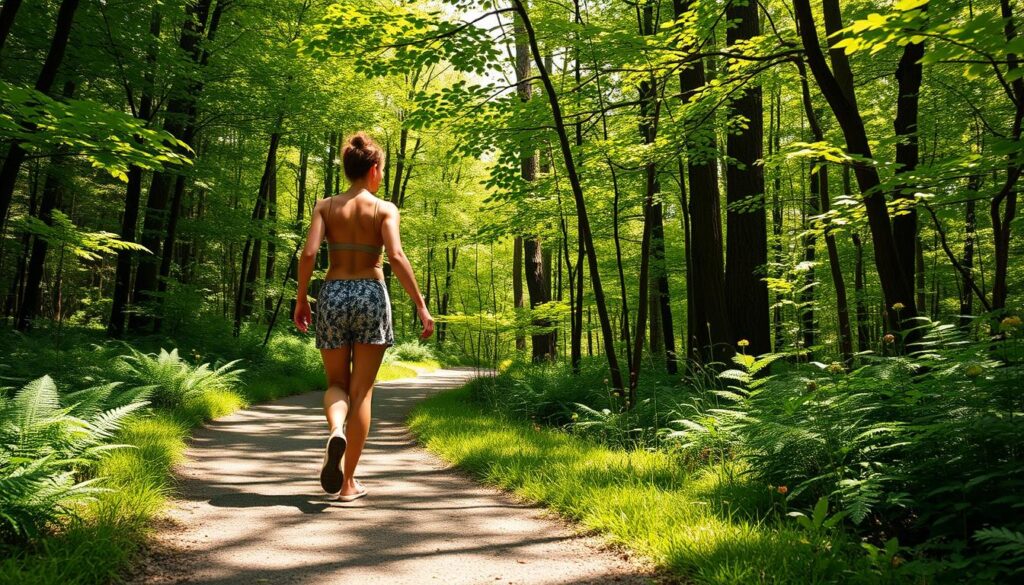
The mindful nature walk is perhaps the most accessible way to begin practicing mindfulness in nature. Unlike ordinary walking, where we often move on autopilot with our minds elsewhere, a mindful walk invites full presence with each step and breath.
How to Practice a Mindful Nature Walk
- Sight: Notice colors, shapes, light, and shadow. Observe how sunlight filters through leaves or how water reflects the sky.
- Sound: Listen to bird calls, rustling leaves, flowing water, or the sound of your own footsteps.
- Touch: Feel the texture of bark, leaves, or stones. Notice the temperature of the air on your skin and the ground beneath your feet.
- Smell: Inhale the scent of soil, flowers, pine needles, or ocean air.
- Taste: If appropriate and safe, taste wild berries or herbs (only if you’re certain they’re edible).
Mindful Walking Tip: If you find your mind particularly busy, try focusing solely on the sensation of your feet touching the earth with each step. This simple anchor can help steady your attention.
Regular mindful walks—even short ones of 15-20 minutes—can significantly reduce stress levels and increase your sense of connection with the natural world. Many practitioners find that this practice becomes a cherished ritual that they look forward to as a way of resetting their nervous system and gaining fresh perspective.
Practice 2: Grounding Exercises in Nature

Grounding exercises create a direct energetic connection between your body and the Earth. These practices help anchor scattered energy, calm an overactive mind, and restore a sense of stability during stressful times. In natural settings, grounding becomes especially powerful as you connect with the Earth’s inherent balancing energies.
Essential Grounding Techniques
Barefoot Meditation (Earthing)
One of the most direct ways to ground yourself is through skin-to-earth contact:
- Find a clean, safe natural surface—grass, sand, soil, or stone.
- Remove your shoes and socks, allowing your bare feet to make direct contact with the earth.
- Stand or sit with your feet firmly planted on the ground.
- Close your eyes and bring awareness to the sensation where your skin meets the earth.
- Imagine roots growing from the soles of your feet deep into the earth, anchoring you.
- Breathe deeply, visualizing that with each inhale you draw earth energy up through your feet, and with each exhale you release tension down into the ground.
- Remain in this practice for 5-20 minutes.
Research suggests that direct physical contact with the Earth’s surface might help regulate your body’s electrical environment, potentially reducing inflammation and improving sleep.
The Five Elements Grounding Practice
This practice connects you with the five natural elements—earth, water, fire, air, and space:
- Sit or stand in a natural area where you can observe multiple elements.
- Begin by touching the earth, feeling its solidity and stability.
- If possible, touch water (a stream, lake, or even morning dew), noticing its flowing, cleansing qualities.
- Feel the warmth of the sun on your skin, connecting with fire’s transformative energy.
- Notice the air moving across your skin and flowing in and out of your lungs.
- Finally, expand your awareness to the spaciousness around you—the sky above and the space between all things.
- Take a moment to feel yourself as part of this interconnected web of elements.
Grounding practices are especially beneficial during times of anxiety, overwhelm, or when you feel disconnected from yourself. Many people find that a brief grounding session in nature can reset their nervous system more effectively than conventional stress management techniques.
Practice 3: Nature Journaling for Mindful Reflection
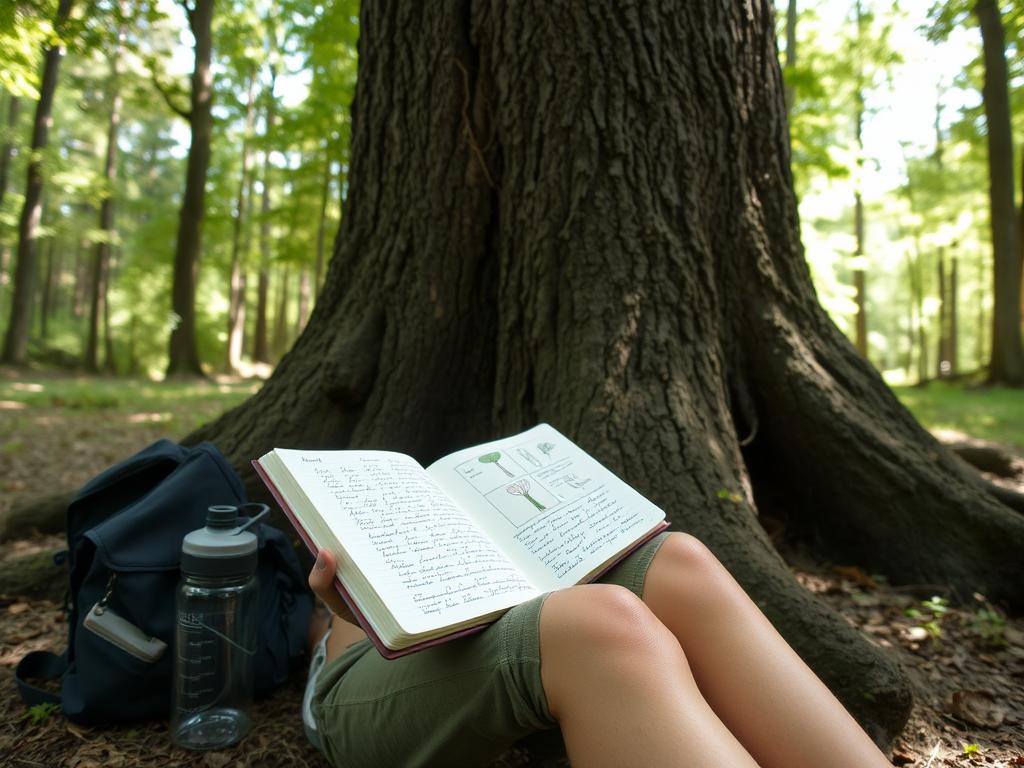
Nature journaling combines the reflective practice of writing with mindful observation of the natural world. This practice deepens your connection with nature by encouraging careful attention to details you might otherwise miss and creating space to process your inner experience of the natural world.
Getting Started with Nature Journaling
You’ll need a notebook, journal, or sketchbook that feels inviting to use, along with a pen or pencil. Optional additions include colored pencils or watercolors if you enjoy incorporating visual elements.
Mindful Journal Prompts for Nature Connection
“The earth has music for those who listen.”
Nature Journaling Practice
- Find a comfortable spot in nature where you can sit undisturbed for 20-30 minutes.
- Begin with a few minutes of mindful breathing to center yourself.
- Open your journal and date the entry.
- Note your location, the weather, and any immediate observations.
- Choose one or more of the prompts above to explore.
- Write freely without judging or editing your thoughts.
- If you feel drawn to sketch something you observe, allow yourself that creative expression.
- Conclude your entry by noting any insights or shifts in perspective you experienced.
Regular nature journaling creates a beautiful record of your evolving relationship with the natural world. Over time, you may notice patterns in what draws your attention and how different natural settings affect your state of mind. This practice also strengthens your observational skills, making each visit to nature richer and more nuanced.
Practice 4: Seasonal Awareness Rituals

Seasonal awareness rituals help us align our inner rhythms with the cycles of the natural world. By mindfully observing and honoring the changing seasons, solstices, equinoxes, and moon phases, we reconnect with ancient patterns that modern life often obscures. These practices remind us that we, too, are natural beings subject to cycles of growth, abundance, release, and rest.
Aligning with Earth’s Natural Cycles
Solstice and Equinox Practices
The solstices and equinoxes mark the turning points of the solar year:
- Spring Equinox (around March 20): Create a ritual of planting seeds—both literal and metaphorical. Meditate on what you wish to grow in your life as the light increases.
- Summer Solstice (around June 21): Rise before dawn to greet the earliest sunrise of the year. Spend time outdoors during the longest day, expressing gratitude for light and abundance.
- Autumn Equinox (around September 22): Practice a letting-go meditation, releasing what no longer serves you as the trees release their leaves. Gather and press colorful leaves as mindfulness anchors.
- Winter Solstice (around December 21): Light candles at sunset and sit in contemplative silence, honoring the darkness and the return of light. Set intentions for the coming solar year.
Moon Cycle Awareness
The lunar cycle offers a more frequent rhythm to align with:
- New Moon: Sit in darkness, embracing the quiet energy of beginnings. Set intentions for the lunar cycle ahead.
- Waxing Moon: Take evening walks under the growing moon, noticing how its increasing light illuminates different aspects of the landscape.
- Full Moon: Practice a gratitude meditation under the full moon, acknowledging what has come to fruition in your life.
- Waning Moon: Release what no longer serves you through a writing ritual, where you list what you’re letting go and then safely burn the paper.
Creating Your Own Seasonal Mindfulness Practice
Seasonal Awareness Tip: Keep a phenology journal—a record of when natural events occur each year, such as the first spring flower, the arrival of certain birds, the first autumn frost. Over time, this creates a beautiful record of your relationship with local natural cycles.
By mindfully aligning with these natural rhythms, you develop a deeper sense of belonging in the great cycles of life. Many practitioners find that seasonal awareness helps them honor similar cycles in their own lives—times for growth, abundance, release, and rest—fostering greater self-compassion and patience.
Practice 5: Eco-Gratitude Practices
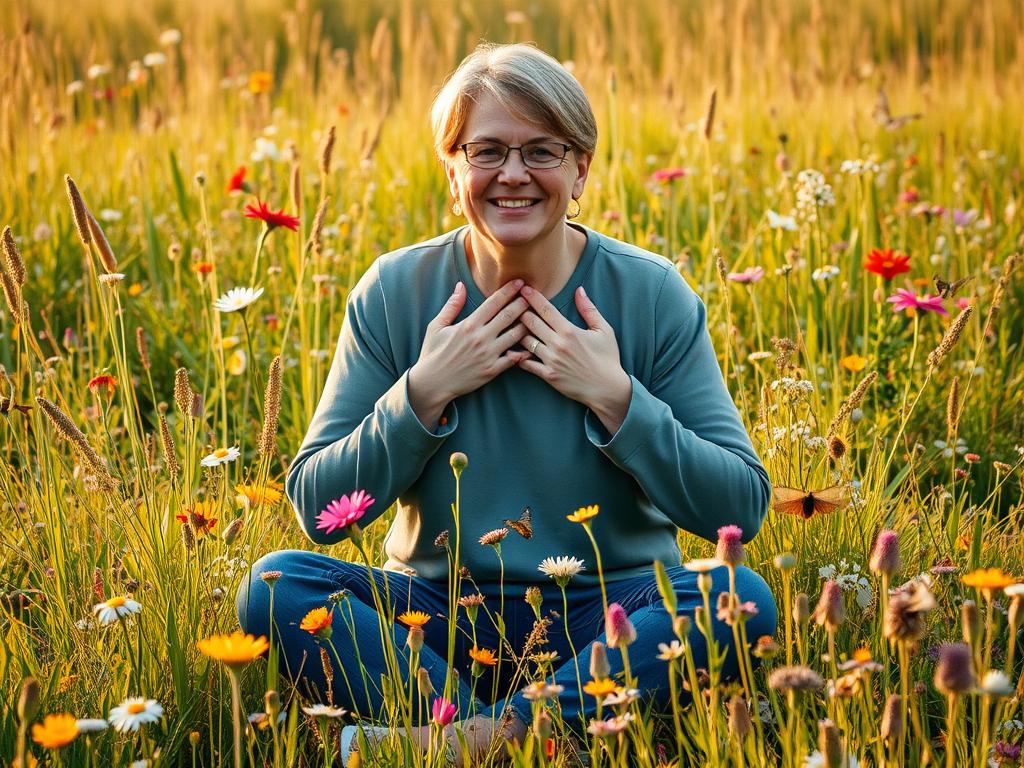
Eco-gratitude practices combine the powerful emotion of gratitude with mindful awareness of our dependence on the natural world. These practices help us recognize and honor the countless ways the Earth supports our existence, from the air we breathe to the food we eat. By cultivating eco-gratitude, we nurture a relationship with nature based on reciprocity rather than exploitation.
Cultivating Thankfulness for the Earth
Daily Eco-Gratitude Meditation
- Find a comfortable position, either seated or standing in a natural setting.
- Close your eyes and take several deep breaths, feeling the air entering and leaving your body.
- Bring awareness to the fact that this breath—this oxygen—comes from plants and trees.
- Silently express gratitude for the plants that create the air you breathe.
- Next, feel the ground beneath you, supporting your body.
- Express gratitude for the Earth that holds you.
- Continue this process, acknowledging the water that sustains you, the sun that provides energy for all life, and the complex web of beings that make up your ecosystem.
- Conclude by placing your hands on your heart and feeling gratitude for being part of this interconnected web of life.
Gratitude Through Action
Eco-gratitude extends beyond feeling thankful to expressing gratitude through concrete actions:
“In the end, we will conserve only what we love, we will love only what we understand, and we will understand only what we are taught.”
Eco-gratitude practices help transform our relationship with the natural world from one of unconscious consumption to conscious appreciation. As this gratitude deepens, many people find themselves naturally making more Earth-friendly choices, not from obligation but from a genuine sense of care for that which sustains us.
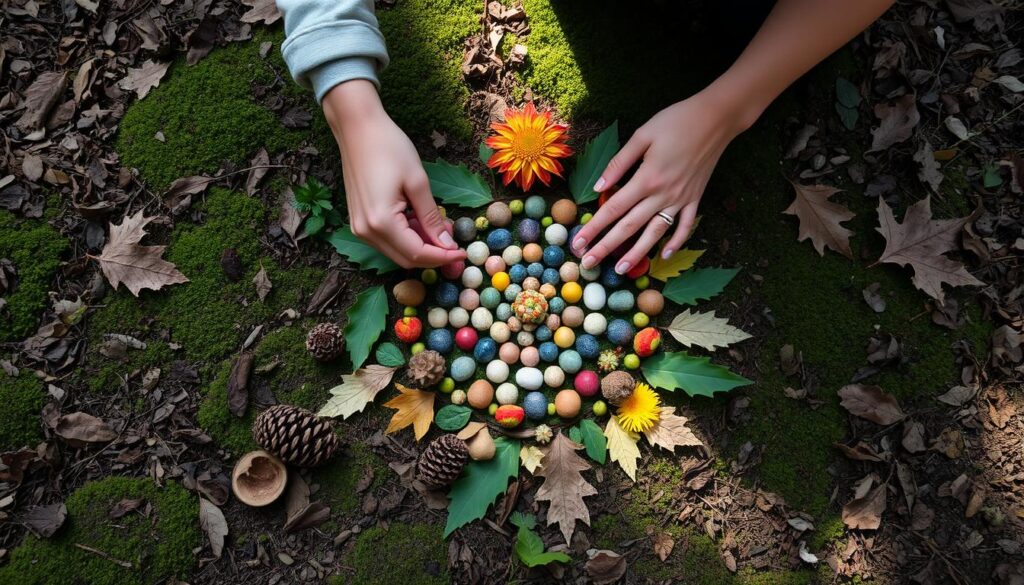
Getting Started: Your 5-Minute Daily Grounding Routine
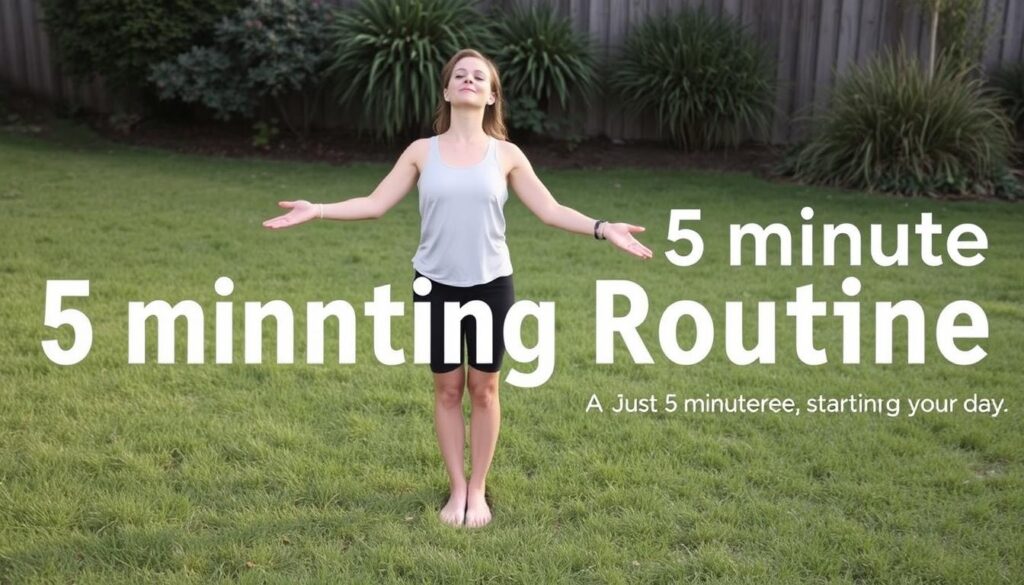
The journey of mindfulness in nature begins with a single step—or in this case, a simple 5-minute practice. This accessible routine can be done almost anywhere you can find a patch of natural ground, making it perfect for busy lives. Consistency with this brief practice often yields more benefits than occasional longer sessions.
Your Daily Earth Connection Ritual
That’s it! Just five minutes of intentional connection can shift your entire day. As this practice becomes habitual, you may naturally find yourself extending the time or incorporating other elements from the practices described in this article.
Consistency Tip: Link your daily grounding practice to an existing habit, such as morning coffee or an evening walk, to help it become a natural part of your routine.
Embracing the Journey of Earth Connection

As you incorporate these mindfulness in nature practices into your life, remember that this is not a destination but a continuing journey of relationship. Each mindful step on the Earth, each moment of gratitude, each seasonal celebration deepens your connection not only with the natural world but with your own natural self.
The practices shared here—mindful walks, grounding exercises, nature journaling, seasonal awareness, and eco-gratitude—offer multiple pathways into this relationship. Some may resonate more strongly with you than others. Trust your intuition about which practices call to you most deeply, while remaining open to exploring all of them over time.
The benefits of this journey extend far beyond personal wellbeing. As you develop a more mindful relationship with nature, you become part of a growing community of Earth-connected humans whose collective awareness is vital for the healing of our planet. Your individual practice ripples outward, influencing those around you and contributing to a culture of greater ecological consciousness.
Begin today with the simple 5-minute grounding practice. Notice how it affects your day. Then gradually explore the other practices, allowing your relationship with the Earth to unfold naturally, just as a seed grows into a plant when given the right conditions.
“The clearest way into the Universe is through a forest wilderness.”
Share Your Earth Connection Journey
We’d love to hear about your experiences practicing mindfulness in nature. What discoveries have you made? How has your relationship with the Earth evolved? Share your story and inspire others on their journey of connection.
Frequently Asked Questions About Mindfulness in Nature
Do I need special training to practice mindfulness in nature?
No special training is required to begin practicing mindfulness in nature. The practices described in this article are accessible to beginners. Start with the 5-minute daily grounding routine and gradually explore other practices as you become comfortable. If you’re interested in deepening your practice, there are many books, online resources, and local groups focused on nature connection and mindfulness.
What if I live in an urban environment with limited access to nature?
Even in urban environments, nature is present. City parks, community gardens, potted plants, and even the sky above offer opportunities for connection. Notice the birds, insects, and plants that thrive in urban settings. A single tree or a small patch of grass can be enough for many of these practices. You might also consider keeping houseplants or creating a small balcony garden to bring more nature into your daily life.
How often should I practice mindfulness in nature?
Consistency is more important than duration. A daily 5-minute practice will likely yield more benefits than an occasional hour-long session. That said, the “right” frequency is whatever works sustainably for your life. Some people incorporate brief moments of nature connection throughout their day, while others prefer a dedicated weekly practice of longer duration. Listen to your own needs and circumstances.
Can children participate in these mindfulness in nature practices?
Absolutely! Children often connect with nature more readily than adults. Simplify the practices for younger children—focus on sensory exploration during walks, create seasonal art projects, or practice gratitude for favorite animals or plants. Nature journaling can be adapted for children who can’t yet write by encouraging them to draw what they observe. These shared practices can become meaningful family rituals that foster a lifelong connection with the natural world.
How do mindfulness in nature practices differ from regular mindfulness meditation?
While traditional mindfulness meditation often focuses on internal awareness (breath, body sensations, thoughts), nature-based mindfulness expands attention to include the living world around us. Nature provides rich sensory anchors that many people find more engaging than breath alone. The natural environment also offers what psychologists call “soft fascination”—a gentle holding of attention that can make mindfulness more accessible, especially for beginners or those with busy minds.
Further Resources for Your Earth Connection Journey
Recommended Books
- “The Nature Fix” by Florence Williams
- “Braiding Sweetgrass” by Robin Wall Kimmerer
- “The Hidden Life of Trees” by Peter Wohlleben
- “Mindfulness in Nature” by Nina Smiley and David Harp
- “The Earth Has a Soul” by C.G. Jung (edited by Meredith Sabini)
Apps & Digital Tools
- iNaturalist – For identifying plants and animals
- Seek – Kid-friendly nature identification
- Insight Timer – Guided nature meditations
- PictureThis – Plant identification and care
- Nature Sounds – Ambient natural soundscapes
Organizations & Communities
- The Association of Nature and Forest Therapy
- Children & Nature Network
- The Wilderness Society
- Local botanical gardens and nature centers
- Community garden associations
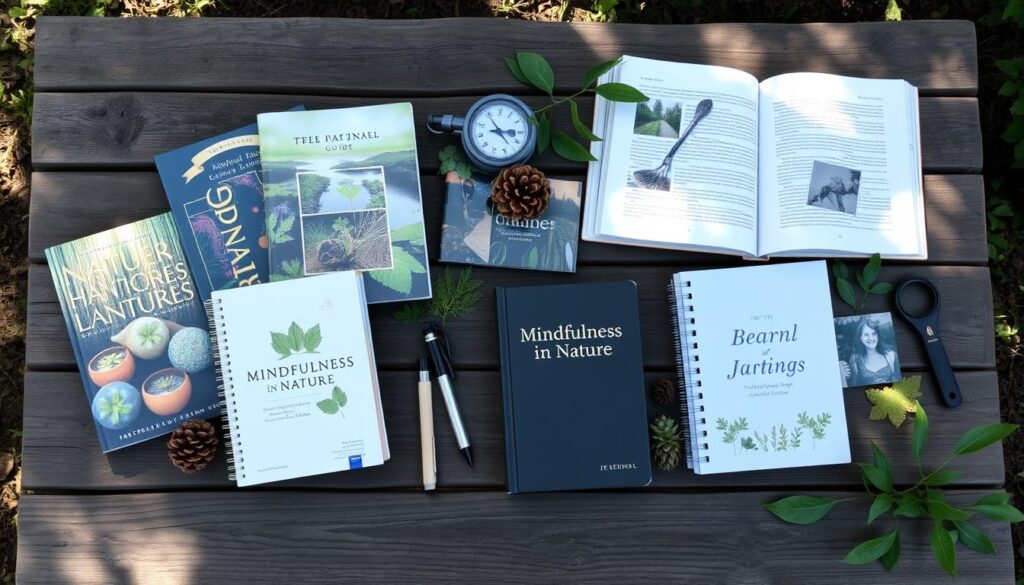
Begin Your Mindfulness in Nature Journey Today
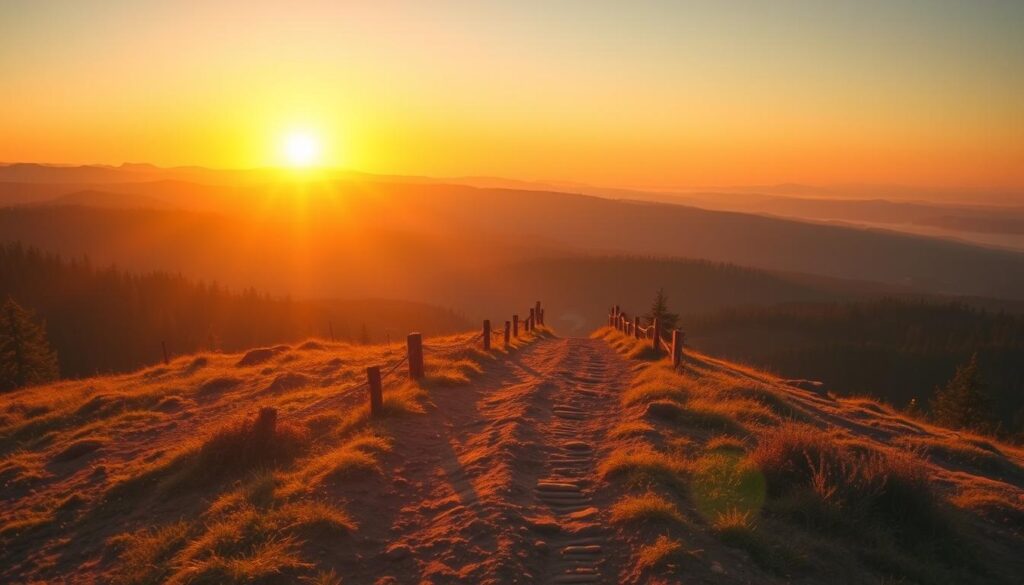
The Earth is always waiting to welcome you back into relationship. Each breath of fresh air, each moment of barefoot connection, each expression of gratitude weaves you more deeply into the web of life that sustains us all. The practices shared in this article offer doorways into this relationship—simple yet profound ways to remember your place in the natural world.
Begin today with just five minutes of intentional connection. Notice how it feels to bring mindful awareness to your relationship with the Earth. Allow this practice to grow organically in your life, expanding and deepening as you’re ready.
Remember that this journey isn’t about perfection—it’s about presence. Each mindful moment in nature is complete in itself, regardless of what came before or what follows. The Earth doesn’t judge your practice; it simply responds to your attention with its own quiet presence.
Take the First Step
Commit to your 5-minute daily grounding practice for the next week. Notice how this small commitment affects your relationship with yourself and the world around you. Then share your experience to inspire others on their journey.






